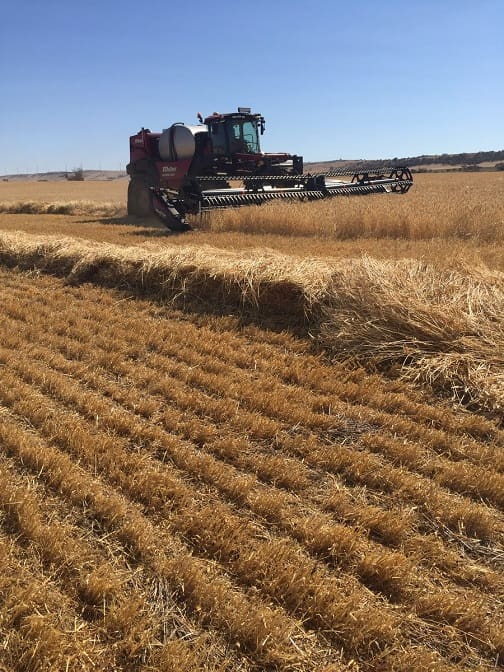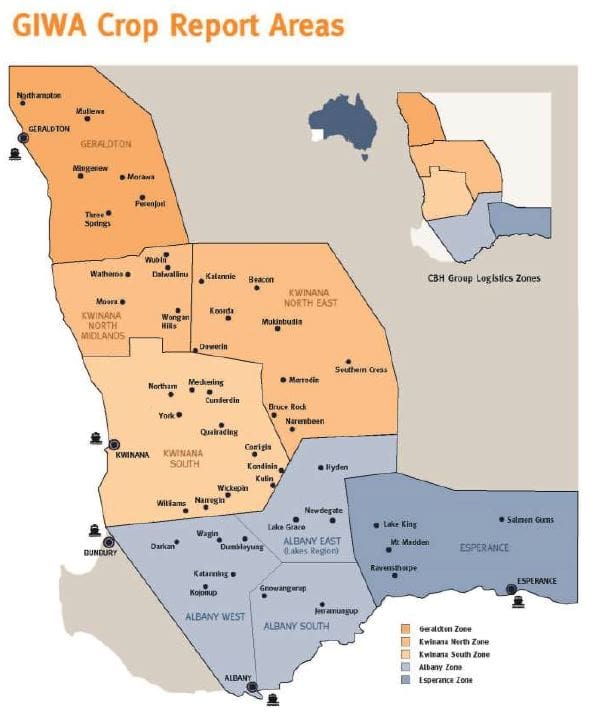THE Western Australian grain season is having one of its hardest finishes in a long time, but most of the crops harvested to date are yielding better than they looked, and most of the crops that growers are going to harvest are filling better than expected.
In its October Crop Report released today, the Grain Industry Association of WA (GIWA) has estimated WA will produce a winter crop of 11.9 million tonnes (Mt) this season – down only slightly from last month’s estimate of 12.3Mt and significantly below last year’s second highest ever crop of 17.9Mt.
GIWA Oilseeds Council chair and crop report author, Michael Lamond, said, in general, the crops had hung on a lot better than expected.
“Cereals are compact and haven’t got a lot of biomass, but they have good head size. That has played out perfectly for the sort of finish we have had. We have had one of the toughest finishes in memory with virtually no rain in spring,” he said.
“Our previous crop report was 12.3Mt at the end of the first week in September. Then we had frost and continuing dry, so we were thinking it would get down to just over 10Mt. But my figure this time is 11.9Mt. It has snuck up.”
Mr Lamond said a lot of people would be surprised by the result.
“But when you go around the state there aren’t too many terrible patches. There are a few in the north, but in most cases growers will break even in every paddock, or make some money,” he said.
 “Once you add that up across the whole state, particularly the big areas in the low rainfall area where they are all going to go 0.8 to 1.5 tonnes/hectare you have a lot of grain.
“Once you add that up across the whole state, particularly the big areas in the low rainfall area where they are all going to go 0.8 to 1.5 tonnes/hectare you have a lot of grain.
“The other thing is that the impact of the frost in the south hasn’t been nearly as great as we thought. Instead of being 1Mt lost it has probably been more like 600,000t. The frost didn’t really have an impact once you got away from the southern area.”
Mr Lamond said grain quality was also looking good this season.
“Because it was a difficult year to manage fertiliser and most growers put a reasonable amount on. There’s a very hard finish. The protein will be good across the board,” he said.
Wheat production in WA will be down to 6.0-6.5Mt this year (last year it was 10.1Mt) and barley is set to push over 4.0Mt (last year it was 5.1Mt).
This would mean the total wheat and barley tonnage for WA could exceed 10Mt, 30 per cent lower than the near record tonnage in 2018 of just over 15Mt for wheat and barley combined.
Mr Lamond said the canola estimate had been put at 880,000t but it could go up to 1Mt because the crop was still green in most cases.
“Due to the late start, most people thought canola would just crash and not yield, but while it looked like it would go 400-500kg/ha, the crops are going 700-800kg/ha.”
“Lupin tonnage will be way down (310,000t) because, even though the crops podded up, they are so short you’ll need a vacuum cleaner to get them up!”
Oat grain yields and oaten hay yields have been disappointing so far with both below average for regions where harvesting/baling has been carried out.
Mr Lamond said the WA harvest was only just getting going with around 100,000t harvested as of Wednesday.
“It is the third week in October and it doesn’t look like it will be much earlier than normal, even though there was such a late start and bad finish,” he said.
Geraldton Zone
Harvesting is underway in the Geraldton Port zone and so far growers are finding grain yields to be a little higher than expected. The better wheat paddock yields are in the 2t/ha range, dropping to the low to mid 1t/ha range for soil types at the two ends of the spectrum of very light and very heavy soils. The deep ripped country is once again delivering the goods with many growers commenting that crops “found something” during grain fill and this has resulted in a yield, seed size and protein advantage over the non- deep ripped paddocks.
The barley grain yields so far have been better than expected with some paddocks similar to or not far behind wheat grain yields. Growers reacted to the late season start by substituting planned paddocks of barley to wheat, coming from a perception that wheat has the ability to fill heads better than barley in a hot dry finish. The barley area has been steadily increasing in the north of the state and the yield results so far this year are encouraging for growers. The combination of new, better adapted varieties and soil amelioration, particularly lime application, have changed the outlook for barley in the region.
The late start to the season had canola in full flower in September and most thought the worst, many estimating most paddocks would only see out 500kg/ha. Grain yields so far are in the range of 800 to 900kg/ha for the better low rainfall areas and up to 1.5t/ha for the coast. The hybrids are well in front of the open pollinated TT varieties and vindicate the dominance of hybrid canola in the north of the state.
Kwinana Zone
Kwinana North Midlands
The Kwinana North East zone is in that transitional area that received some very high individual rainfall events in early winter. These rainfall events leached nutrients, causing deficiencies in the western areas and resulting in a lack of biomass. Cereal head size is large from good growing conditions over the first few weeks following the break to the season. This combination of low tiller numbers, short compact growth and large head size has resulted in the best possible scenario as the season has played out. The crops that have been harvested are generally yielding 10 to 20pc better than they look.
In the eastern areas of the zone, crops did not receive the heavy leaching rains. They are still compact due to the tough growing conditions from the lack of rain, displaying very efficient grain fill with water use efficiencies “off the scale”.
Across the region, grain production will be half of last year in the west, and two-thirds down in the east.
Kwinana South
Harvesting is just starting to get underway in the region. Barley has finished quicker than canola and will be harvested first. The growers who still swath canola have started, and wheat will be a few weeks off being ready for harvesting.
The western areas of the Kwinana South zone were holding up well until recently and could have benefited from another rain. Now the top in the yield is coming off and the crops and most will be “average or below average” rather than “average to above average” from a couple of weeks ago. Barley will still be higher yielding than wheat, as per usual. There is more barley sown than wheat in the western areas of the zone and this contributed significantly to the five million tonnes plus of barley produced last year.
The canola area is down slightly in the region, particularly towards the eastern areas of the zone; grain yields will be well down on 2018.
Kwinana North East
The Kwinana North East zone is going to be below average except for those pockets that picked up a few more millimetres from storms in the winter and spring. Some areas in the far east of the zone had more rainfall to work with from pre-season rainfall events and received a little more rain than further west in the spring. These areas will be close to or above average. In general, north of the Great Eastern Highway will not be as good as south of the highway, and some areas east of Merredin will be better than those to the west.
Wheat in particular has hung on much better than most growers thought it would and even though there will be big areas of the zone below average, the zone as a whole will still produce a lot of grain as there are no seriously poor patches.
Albany Zone
Albany West
The West Albany zone was looking above average until recently although the complete lack of spring rain is starting to hit now, with crops going off very quickly. Many growers have commented that the colour change in crops has been much faster than normal. The earlier sown crops have been in front all year and the spread in yield will be large from those to the majority of crops that emerged following the general break in June.
The canola is in front of the barley in maturity for crops emerging in May and whilst grain yields will be down on last year, grain yield should be in the over 1.5t/ha range.
Albany South
There has been little crop harvested in the region to date. Some canola and barley are being harvested in the north east areas that had the very dry year. Grain yields are below 500kg/ha for canola and under 1.5t/ha for barley which is a bit better than expected considering some of these areas were in the lowest recorded percentile of rainfall, as well as being frosted.
Closer to the coast there has been some reprieve from the frost following late rain in early October, although most growers would still be happy if grain yields were close to average. Harvest index for cereals is expected to be good and higher than expected grain yields could result from more efficient grain fill.
Albany East (Lakes Region)
There will be no surprises in grain yield for the Lakes region. The start to the season was late and rainfall has been below average with no summer rain to provide a reserve. Harvesting barley will commence in about a week. There does not appear to be as much significant damage from the frosts as growers thought because crops were not at their susceptible growth stages when the frosts hit. Grain yields will be higher in the north and western areas of the region as is mostly the case. The eastern areas did pick up some late rain and this will push grain yields closer to average for some growers.
Esperance Zone
Now that the full extent of severe frost events have been assessed there has been an increase in expected tonnage on estimates of about 300,000t. There has been some recovery in paddocks that were not completely wiped out and have now been cut for hay, following light rainfall in early October. The barley that survived the frost has compensated with grain size as it often does, and the canola and pulses have recovered better than expected.
There will be a large range in individual paddock yields due to the frost, making it very difficult to estimate where final tonnage will end up. As well as this, some of the areas that looked good prior to the frost and then escaped damage, will turn out to be better than good. Closer to the coast there will be some very good yields for barley and canola.
The western areas of the zone received some good rainfall in early October and crops were late enough to benefit them. Some early grain yields are in the 1.5t/ha range rather than below 1.0t/ha as it would have been without that late rainfall event.
Source: GIWA
Grain Central: Get our free daily cropping news straight to your inbox – Click here



HAVE YOUR SAY